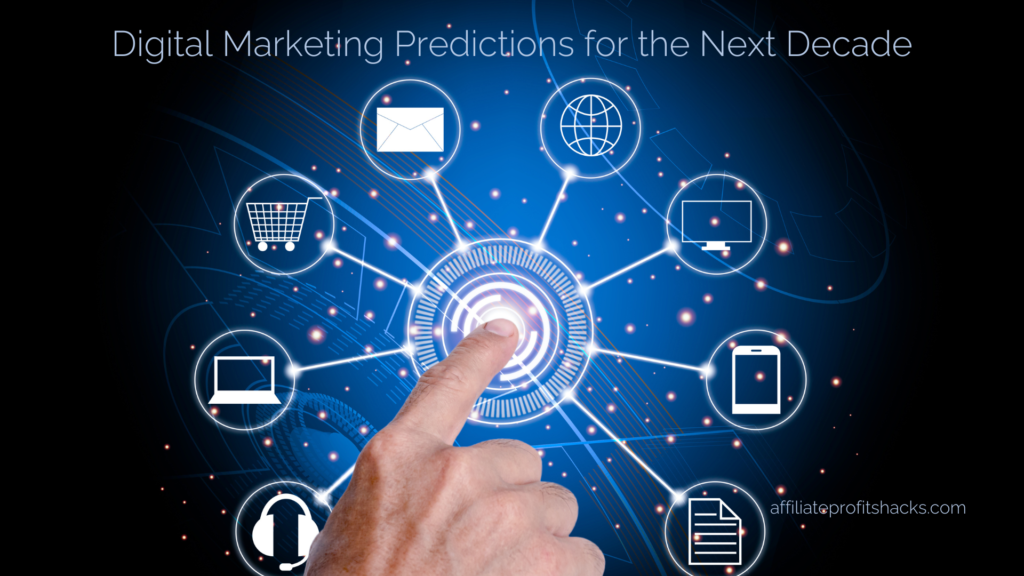Digital Marketing Predictions for the Next Decade
Welcome to my article about Digital Marketing Predictions for the Next Decade!
Did you know that by 2030, it is estimated that global digital advertising spending will reach a staggering $645 billion? With such a massive investment in digital marketing, it’s evident that businesses are recognizing its potential for growth and success in the future.
Digital marketing will significantly transform in the next decade, driven by technological advancements and changing consumer behaviors. From the resurgence of content marketing to the integration of augmented reality, digital marketers must stay ahead of the curve to effectively reach and engage their target audience.
Ready for Real Change? Watch Our Life-Changing Video Now!

Key Takeaways:
- Digital advertising spending is projected to reach $645 billion by 2030.
- The next decade will witness major transformations in digital marketing.
- Marketers need to adapt to emerging trends to stay relevant and connected.
- Content marketing, AI, voice-activated technology, and augmented reality will shape the future of digital marketing.
- Businesses must prioritize personalization, sustainability, and ethical practices to build stronger customer connections.
Content Marketing’s Big Comeback
Content marketing is expected to make a powerful comeback in the next decade. With Google emphasizing the importance of high-quality content for SEO, investing in content marketing has become essential for businesses. As a digital marketer, you need to understand the significance of content marketing for your overall marketing strategy and the positive impact it can have on your business.
In fact, according to recent statistics, 61% of marketers expect better business performance in 2024 by investing in content marketing. This highlights the growing recognition of content marketing as a crucial component of a successful digital marketing strategy. It’s not just about creating any content; it’s about creating valuable, relevant, and engaging content that resonates with your target audience.
One of the main reasons behind the increased focus on content marketing is its impact on SEO. Search engines, particularly Google, prioritize high-quality content that provides value to users. By consistently producing relevant and informative content, you can improve your search engine rankings and drive organic traffic to your website.
As a result, marketers are allocating more resources to content creation. Data shows that 41% of marketers plan to increase their content budgets, recognizing the need to produce more quality content to stay competitive in the digital landscape.
Here’s how content marketing can benefit your business:
- Boost your organic search visibility and improve your SEO rankings
- Establish your brand as a thought leader and industry expert
- Build trust and credibility with your target audience
- Increase brand awareness and reach a wider audience
- Generate qualified leads and drive conversions
- Nurture customer relationships and foster brand loyalty
So, as you plan your digital marketing strategy for the next decade, it’s crucial to prioritize content marketing and allocate sufficient resources. Creating valuable content that resonates with your target audience can boost your SEO efforts, increase brand visibility, and drive business growth.
“Content marketing is the heart of any successful digital marketing strategy. It’s not just about creating content, but about creating content that adds value to your audience’s lives and establishes your brand as a trusted authority.” – Digital Marketing Expert
AI-Generated Content
AI is rapidly advancing and challenging the way content is created. While AI is not yet capable of penning Pulitzer-worthy blogs, major outlets have begun using AI for basic content generation. The future holds promise for more complex AI-generated content. This advancement in AI technology is causing a shift in how content quality and purpose are perceived.
As AI continues to develop, it has the potential to streamline content creation processes, saving time and resources. AI algorithms can analyze vast amounts of data to identify patterns and trends, providing valuable insights for content creators. With the ability to generate content based on these insights, AI has the potential to enhance content quality and relevance.
However, some challenges come with AI-generated content. The lack of human creativity and emotional intelligence can sometimes result in content that feels robotic and lacks authenticity. Balancing AI-generated content and human creativity is essential to ensure the best possible outcome.
The use of AI-generated content is not meant to replace human creativity. Instead, it should be seen as a tool to augment and enhance the content creation process.
AI-generated content also raises ethical concerns. As AI algorithms become more sophisticated, there is a risk of misinformation and manipulation. It is crucial to have stringent guidelines and checks to ensure AI-generated content’s accuracy and integrity.
Benefits of AI-Generated Content
Despite its limitations, AI-generated content offers businesses and content creators several benefits. Here are some of the key advantages:
- Increased efficiency: AI can automate content creation processes, reducing time and effort.
- Data-driven insights: AI algorithms can analyze vast amounts of data, providing valuable insights to inform content strategy.
- Enhanced personalization: AI can tailor content to individual preferences, delivering personalized experiences at scale.
- Improved content quality: AI-generated content can help produce error-free, grammatically correct, consistent content.
The future of content creation lies in a collaborative approach combining AI’s and human creativity’s strengths. By leveraging AI technology effectively, businesses can achieve higher efficiency, improved content quality, and enhanced audience engagement.
Voice-powered Everything
Voice-activated technology has become increasingly popular in 2024, with smart speakers and virtual assistants taking center stage. The convenience of voice commands has led to a significant rise in voice search queries, making it the preferred method for most users. According to recent statistics, over 60% of all searches are now conducted using voice-activated technology.
This trend has opened up new and unique marketing opportunities for brands. With voice-activated assistants becoming integral to consumers’ daily lives, targeted advertising through these devices has become increasingly prevalent. Innovative advertising strategies are being developed to engage users through voice-activated technology, creating a more personalized and interactive consumer experience.
Voice-activated technology has completely transformed the way we interact with devices and access information. As this technology continues to evolve, brands can leverage the popularity of smart speakers and virtual assistants to reach their target audience in new and exciting ways.
One of the key advantages of advertising through voice-activated technology is its ability to deliver tailored content and recommendations based on user preferences and behavior. Smart speakers and virtual assistants can access vast data, allowing brands to create highly targeted and personalized advertising campaigns.
By optimizing content for voice search and integrating voice-activated technology into marketing strategies, brands can stay ahead of the curve and connect with consumers more meaningfully and engagingly. As the popularity of voice-activated technology continues to grow, innovative advertising techniques will continue to emerge, presenting exciting possibilities for brands looking to make a lasting impression in the digital landscape.
Ready for Real Change? Watch Our Life-Changing Video Now!
Key takeaways:
- Voice-activated technology, such as smart speakers and virtual assistants, is thriving in 2024.
- A majority of all searches are now voice-based, presenting unique marketing opportunities.
- Targeted advertising through voice-activated assistants is becoming more prevalent.
- Brands can leverage the popularity of voice-activated technology to create personalized and interactive experiences.
- Optimizing content for voice search is essential for staying ahead in the evolving digital marketing landscape.
Augmented Reality Becomes Commonplace
Augmented reality (AR) is no longer just a fun gimmick for gamers. It is now being used as a tool for brands to reach customers. AR offers immersive experiences that engage users and enhance the buying journey. From virtual try-ons to interactive advertisements, brands are finding innovative ways to leverage AR technology and provide unique customer experiences.
With augmented reality, users can visualize products in their own space before purchasing, eliminating the guesswork and increasing confidence. For example, furniture retailers allow customers to virtually place furniture pieces in their homes to see how they fit and complement the existing decor. This immersive experience helps customers make informed decisions and reduces the likelihood of returns.
Brands can also create interactive advertisements using AR, allowing customers to engage with the products in a captivating and memorable way. AR-powered games and challenges can be integrated into marketing campaigns to entertain and incentivize customers, increasing brand awareness and customer loyalty.
Augmented reality offers endless possibilities for marketers to create meaningful connections with their audience. By providing immersive experiences, brands can stand out and create lasting impressions. As AR technology advances, we can expect to see even more innovative applications that blur the lines between the physical and digital worlds.
Video Overtaking All Other Digital Channels
Video content has revolutionized the digital landscape and shows no signs of slowing down in the next decade. With over 82% of all consumer internet traffic attributed to video content, it has become a powerful medium for engaging audiences and driving results.
One of the key advantages of video content is its unmatched ability to captivate viewers and leave a lasting impression. Studies show that viewers retain 95% of the information in videos, making it an effective tool for delivering messages and building brand awareness. By leveraging the dynamic nature of video, marketers can convey emotions, tell stories, and create memorable experiences that resonate with their target audience.
Furthermore, video marketing has proven to be a highly effective lead-generation tool. Research suggests that video marketers generate 66% more qualified leads than those who do not utilize video content. This is due to the inherent power of video in capturing attention, conveying value propositions, and guiding prospects through the sales funnel.
Integrating live video and augmented reality has further elevated video content engagement and lead-generation potential. Live video allows brands to interact with their audience in real time, fostering a sense of community and authenticity. On the other hand, augmented reality adds a new dimension to video experiences, enabling users to engage with products and services in an immersive and interactive manner.
Video content has become the go-to medium for brands looking to make a lasting impact in the digital landscape. Its ability to engage, educate, and entertain has positioned it as a must-have in any comprehensive marketing strategy.
In conclusion, video content is set to dominate the digital space in the next decade. Its ability to drive internet traffic, enhance engagement, and generate leads makes it an invaluable tool for marketers. By harnessing the power of video, brands can create compelling experiences that capture the attention of their target audience and drive meaningful results.
Personalization at Scale
In today’s digital age, consumers have come to expect personalized experiences. Brands increasingly recognize the importance of catering to individual needs and preferences, and this demand for personalization is only expected to grow in the next decade. By leveraging the power of AI and machine learning, businesses can now deliver tailored experiences at scale, creating content that resonates on a personal level.
AI and machine learning technologies have revolutionized the way brands understand their customers. Through advanced algorithms, businesses can analyze vast amounts of data to gain insights into individual preferences, behaviors, and interests. This allows them to deliver personalized content, offers, and highly relevant recommendations to each customer.
Personalization is not just about inserting a customer’s name in an email. It’s about understanding their unique needs and delivering valuable experiences that make them feel seen and understood.
Through AI and machine learning, brands can go beyond traditional demographic segmentation and create dynamic customer profiles that continuously evolve based on real-time data. This enables them to adapt their content and marketing strategies in real time, ensuring that every interaction with the customer is meaningful and personalized.
For example, imagine receiving an email from your favorite online retailer showcasing products tailored to your browsing and purchasing history. This level of personalization enhances the customer experience and increases the likelihood of engagement and conversion.
Moreover, personalization at scale extends beyond just marketing efforts. With AI-powered customer service chatbots, businesses can provide personalized support and assistance to customers 24/7. These chatbots can understand customer inquiries, provide accurate answers, and even make personalized product recommendations, all in a conversational and natural language format.
Image:
By harnessing the power of personalization, brands can strengthen customer loyalty, increase customer satisfaction, and ultimately drive business growth. As technology advances and AI becomes more sophisticated, the possibilities for personalization at scale are infinite.
Voice Search Optimization
With the rising popularity of smart speakers and voice-activated devices, voice search optimization has become crucial. Brands that adapt their content for voice search gain a significant advantage in making their products and services more accessible through conversational queries.
Voice search has revolutionized the way people interact with technology. Users can now ask questions out loud instead of typing queries into search engines and receive immediate responses. This shift in search behavior has led to the rise of conversational queries, where users ask questions more naturally, human-like.
Optimizing for voice search involves understanding the nuances of conversational queries and tailoring your content to match how people speak. Instead of focusing solely on specific keywords, it’s important to incorporate long-tail phrases and natural language into your content. This helps search engines recognize the relevancy of your content to voice search queries.
In addition to adapting content, there are other strategies you can employ to optimize for voice search:
- Structured data markup: Adding structured data to your website helps search engines understand and categorize your content more effectively, increasing its chances of being selected as a voice search result.
- FAQ pages: Creating a dedicated Frequently Asked Questions (FAQ) page helps address common voice search queries and provides concise answers that voice assistants can easily read aloud.
- Local SEO: Voice search often includes location-based queries like “Where is the nearest coffee shop?” Optimizing your website for local SEO can help your business appear in voice search results for relevant location-based queries.
Ready for Real Change? Watch Our Life-Changing Video Now!
Voice search optimization is not only about technology but also about enhancing accessibility. By optimizing for voice search, brands are able to reach a wider audience, including those with physical disabilities or individuals who prefer using voice-enabled devices for convenience.
As voice-activated technology continues to evolve and become more integrated into our daily lives, optimizing for voice search is vital for businesses that want to stay relevant and accessible to their target audience. By understanding the nuances of conversational queries and implementing effective optimization strategies, brands can position themselves at the forefront of voice search and gain a competitive edge in the digital landscape.
Sustainability and Ethical Marketing
Consumers are increasingly conscious of environmental and social issues. Brands prioritizing sustainability and ethical practices in their marketing strategies build stronger connections with their audience. Transparency and genuine commitment to making a positive impact are key to winning customer trust and loyalty.
The Importance of Sustainability
Sustainability has become a major concern for consumers in recent years. People actively seek brands that demonstrate a commitment to reducing their environmental impact. Businesses can align themselves with this growing consumer demand by implementing sustainable practices, such as using renewable energy sources, minimizing waste, and reducing carbon emissions.
Ethical Practices for Social Impact
Ethical practices go beyond sustainability and extend to socially responsible actions. Consumers appreciate brands that demonstrate fairness, integrity, and accountability in their operations. This includes ensuring fair treatment of employees, maintaining safe working conditions, supporting diversity and inclusion, and upholding human rights standards throughout their supply chains.
Sustainability is no longer a choice; it’s a necessity. Today’s consumers expect businesses to take responsibility for their impact on the planet and society at large. By adopting ethical and sustainable practices, brands can differentiate themselves and create a positive reputation among consumers.
Transparency Builds Trust
Transparency is a crucial element of sustainable and ethical marketing. Consumers want to know where their products come from, how they are made, and their impact on the environment and society. By providing clear information and openly communicating about their practices, brands can establish trust and credibility with their audience.
Furthermore, transparent communication enables consumers to make informed choices that align with their values. Brands that openly share information about their sustainability initiatives, ethical sourcing, and social impact can attract and retain customers who prioritize these values.
The Role of Consumer Activism
Consumer activism plays a significant role in shaping sustainable and ethical marketing practices. As consumers become more educated about environmental and social issues, they actively support brands that align with their values and boycott those that do not. Social media has given consumers a powerful platform to voice their concerns and hold brands accountable.
Brands, therefore, need to listen to their customers, engage in transparent dialogue, and take meaningful action to address their concerns. By actively responding to consumer feedback and continuously improving their sustainability and ethical practices, brands can foster long-term relationships based on trust and shared values.
The image above further emphasizes the importance of sustainability and ethical practices in marketing.
AI-Powered Marketing and Support Technology
AI has revolutionized digital marketing by empowering businesses to optimize their strategies in various key areas. From personalized customer service to ad optimization, AI technologies are reshaping the landscape and improving overall marketing effectiveness.
Efficient Customer Service with Chatbots
Chatbots, powered by AI, have become the go-to solution for efficient customer service. They handle inquiries, provide instant responses, and even guide users through troubleshooting processes. By automating routine tasks, chatbots relieve human agents, enabling them to focus on more strategic initiatives. This improves customer satisfaction, reduces response times, and streamlines the customer support process.
Fine-tuning Ads for Maximum Impact
AI-powered ad optimization is transforming the way marketers approach advertising. Using machine learning algorithms, AI analyzes user behavior and reactions to ad campaigns, allowing marketers to refine their strategies and maximize ad performance. By analyzing data in real-time, AI technologies can identify the most effective elements in an ad and adjust them accordingly. This leads to improved targeting, better engagement, and increased ROI.
AI offers various capabilities, helping marketers and businesses achieve their goals more effectively. Whether it’s personalized customer service through chatbots or ad optimization powered by machine learning, AI drives innovation and efficiency in digital marketing.

Interactive and Shoppable Content
In today’s digital landscape, interactive content and shoppable posts revolutionize how consumers engage with brands. Through interactive elements such as quizzes, polls, and videos, brands can create a more immersive and personalized experience for their audience, increasing social media engagement and brand loyalty.
With the rise of social media platforms as shopping destinations, shoppable posts have become an effective way for brands to connect with their audience and drive sales seamlessly. By incorporating direct shopping links into their social media posts, brands can simplify the purchasing process for consumers, allowing them to purchase directly from their favorite social media platforms.
Interactive and shoppable content encourages social media engagement and provides a seamless shopping experience from discovery to purchase. Consumers can now discover products through interactive content, engage with brands, and make a purchase without leaving their preferred social media platform.
Take, for example, a fashion brand that creates an interactive video showcasing its latest collection. Viewers can explore different outfit options, participate in polls to vote for their favorite styles, and even shop the featured products within the video. This creates an immersive and enjoyable shopping experience that drives engagement and conversions.
Benefits of Interactive and Shoppable Content
Interactive and shoppable content offers several key benefits for both brands and consumers:
- Increased Engagement: Interactive elements capture consumers’ attention and encourage them to interact more with a brand’s content, resulting in higher engagement rates.
- Seamless Shopping: Shoppable posts enable consumers to purchase directly from their social media feeds, eliminating the need to navigate to a separate website or store.
- Personalization: Interactive content allows brands to tailor the user experience based on individual preferences, providing a more personalized and targeted approach to marketing.
- Improved Conversions: By integrating shoppable links into their content, brands can streamline the path to purchase, leading to higher conversion rates and increased sales.
- Enhanced Brand Loyalty: Interactive and shoppable content strengthens the bond between brands and their audience, fostering loyalty and advocacy among consumers.
Ready for Real Change? Watch Our Life-Changing Video Now!
As the demand for seamless shopping experiences and engaging content grows, interactive and shoppable content is expected to become even more prevalent. Brands that embrace these trends and utilize interactive and shoppable content strategies will be well-positioned to drive social media engagement and increase conversions in the evolving digital marketing landscape.
Conclusion
The future of digital marketing in the next decade holds exciting possibilities. With the resurgence of content marketing and the advancement of AI, the digital landscape is set to transform in significant ways. As voice-activated technology continues to rise and augmented reality becomes commonplace, brands have new avenues to engage with their audience. Video content remains dominant, driving internet traffic and generating qualified leads.
Consumers are demanding personalization at scale, and businesses must adapt to meet this expectation. By prioritizing sustainability and ethical practices, brands can build strong connections and earn the trust of their audience. AI-powered technologies like chatbots will play a crucial role in marketing and customer service, streamlining interactions and improving efficiency. Interactive and shoppable content will provide seamless shopping experiences, making it easier for consumers to engage and purchase.
As businesses enter the next decade, embracing these digital marketing predictions and leveraging the opportunities they present is vital. Staying ahead of the ever-evolving landscape will be key to achieving success in the future of digital marketing.
Thank you for reading my article “Digital Marketing Predictions for the Next Decade.” I hope you found it informative and helpful!
For more insights into Digital Marketing, read this article: Digital Marketing Masterclass: Take Your Business To The Next Level.







